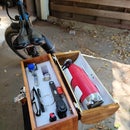Introduction: Hydroponic Oxygen Infuser
I have been developing this device over the course of 10 years. this is a is a device that adds dissolved oxygen and oxygen microbubbles to water in a hydroponic system. Oxygen is important for plant growth and health in hydroponic systems for several reasons. First, dissolved oxygen is necessary for plants to convert CO2 into energy during photosynthesis. Second, oxygen helps to inhibit the formation of harmful bacteria and fungi, which can cause root rot and other diseases and encourages the growth of beneficial bacteria that keep the water clean. Perhaps most important is the the presence of dissolved oxygen helps the in the plants uptake of nutrients from water. See my previous instructable on this system from 2013. https://www.instructables.com/Mini-Hydroponic-aeration-tower/
Supplies
3 Wine Aerators from Amazon or a wine store these are also known as Vinturi's they are actually venturi's
West system Gflex 650 2 part epoxy. This is one of the few epoxies rated for gluing plastics.
6 inch PVC pipe with the coupling end. but practically any vessel, bucket or container that you can glue the Vintui's and an overflow tube to will work.
I cut the holder and top out of an old 1/2" thick HDPE cutting board retired form our kitchen.
If you leave the top off the device you run the risk of growing algae that's not good, cover it up with something.
Hole saws and drill
Utility Knife for deburing holes
80 grit sandpaper to prepare the plastics for gluing
Propane torch to prepare the HDPE for gluing.
I used my CNC router to cut the HDPE but that can be done by hand and hole saw.
Step 1: Prepare the Material
Prepare the material your using to accept the Wine Vinturi's. I used an 1 3/4" hole saw. the Vinturi's are conveniently tapered in their outer shape so there are multiple possibility's fore hole size. Also drill a hole for the overflow elbow.
Step 2: Prepare for Gluing
Glue the Vinturi's into place. Prepare by sanding the mating surfaces with 80 grit. Then if your using HDPE alcohol wipe it then lightly torch the mating surface on that but don't let it melt. then put it together. the taper on the Vinturi makes it east to pour the epoxy in from the top.
Step 3: Glue It Up
Then glue the base that holds the Vinturi's into the PVC Pipe the overflow elbow can be glued in at this time also.
Step 4: Check Out the Video
Please See My YouTube Video for further details
Step 5: Why Have Multiple Venturi's
My greenhouse is a low flow system that is powered by 2 100 watt solar panels, thats right, the pump only runs during daylight hours. This has no ill effects on the plants. The multi venturi design is based on reducing flow restriction and reducing the size of the venturi low pressure tap (vacuum intake hole). The smaller the tap the smaller the bubble, the smaller the bubble the more surface area, the more surface area the more of an interface between the liquid and gas. So more gas can be absorbed by the liquid. More venturi's = more dissolved oxygen.
Step 6: Conclusion
Over the years I have built many of these systems for Hydroponic deep water culture (DWC) I've used them indoors, Outdoors, Aerating ponds and my greenhouse. I've grown high CBD cannabis, tomatoes, watercress, broccoli, eggplant, basil basically anything except root crops. I've alawys had a stellar harvest (excepting a few times that I myself caused a failure or was raided by critters)
Step 7:
See the video for more information.

Participated in the
Backyard Contest













